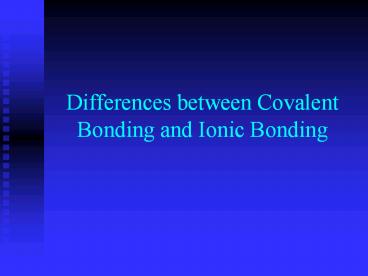Differences between Covalent Bonding and Ionic Bonding - PowerPoint PPT Presentation
1 / 14
Title:
Differences between Covalent Bonding and Ionic Bonding
Description:
Covalent bonding is a sharing of electrons, Ionic bonding is a transfer of electrons. ... similar to a magnet. Oxygen. H. Water has 2 polar covalent bonds, meaning. – PowerPoint PPT presentation
Number of Views:368
Avg rating:3.0/5.0
Title: Differences between Covalent Bonding and Ionic Bonding
1
Differences between Covalent Bonding and Ionic
Bonding
2
Major difference
- Covalent bonding is a sharing of electrons, Ionic
bonding is a transfer of electrons. - Covalent bonds are stronger than ionic bonds
because there is actually an electron going
between them. - Therefore, it is harder to break a covalent bond
than it is to break an ionic bond. - This is why we didnt dissociate the polyatomic
ions, they are held together with covalent bonds.
3
Shortcut to determining type of bond
- When a metal and nonmetal bond you get an ionic
bond - something from the left excluding H bonds with
something from the right ionic bond. - When two nonmetals bond you get a covalent bond
- things from the right bond with each other
covalent bond. - Metals dont bond with each other.
4
Why this works
- Electronegativity- ability of an atom to attract
and hold bonding electrons. - Elements with a large difference in
electronegativity will form an ionic bond,
elements with a small difference will form
covalent bonds.
5
Using the periodic table to determine
electronegativity
- electronegativity generally increases up and to
the right excluding noble gases. - Fluorine is the most electronegative element
(4.0) followed by oxygen (3.5) and chlorine
(3.0). - A full chart is on page 344.
6
Electronegativity Chart
7
What about the middle ground?
- What if the difference in electronegativity isnt
large or small but in the middle? - For example H (2.1) and O (3.5)
- These elements form a polar covalent bond.
- Polar Covalent Bond- unequal sharing of electrons
in the bond - so the electrons stay around oxygen more than
hydrogen
8
Polar covalent
- 4 electrons occupy this cloud.
- Notice how much larger the cloud is around oxygen
as compared to hydrogen.
9
Do any bonds have an equal sharing?
- Yes, (normally the same element) when elements
are equally electronegative like O2 - In fact, anything with a very slim difference
(less than 0.5) in electronegativity will pretty
much equally share electrons. - Nonpolar covalent bonding- equal sharing of
electrons in a bond
10
Bonds
11
Why it is called polar
polar implies different ends have different
charges similar to a magnet.
Water has 2 polar covalent bonds, meaning the
electrons stay around oxygen more than H
H
Oxygen
and this side positive
That makes this side negative
H
12
Denoting positive and negative
Neither side is completely positive or
negative, they are only partially positive and
partially negative.
?
?
H
H
Oxygen
The symbol ? (lower case delta) means partial
? 2-
13
Dipole Moment
- Dipole moment- property of a molecule where the
charge distribution can be represented by a
center of a positive charge and a center of
negative charge. - It is represented by this symbol
- Positive center Negative
center
14
So the dipole moment for water
is represented like this. Note the center of the
positive charge is in between the two hydrogen
atoms.
H
H
Oxygen

